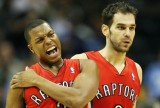From time to time, we will turn our writing desk over to our readers who in turn will provide us their insight and different spin on all things Raptors. In this edition:
Tom Liston
Tom is an Equity Research Analyst by day and a long-time Raptors supporter at night. He is a recent season ticketholder (i.e. sucker for punishment) and an excellent referee from 125 feet away. Liston despises “tanking”, thinks Calderon is underrated, is on a mission to end the booing of VC, and will miss “Hump’s Dad”. He’s from the hotbed of Canadian basketball (New Brunswick obviously) where he was a very undersized but effective rebounder – just don’t ask him to dribble through traffic. He believes taking a charge and bruising for an offensive board are the two best plays in the game and he thinks the Raptors TwitFam is the best in the NBA
Email: tomliston at hotmail.com <> twitter.com/Liston
I’ve recently read a number of articles and blog posts on the importance of rebounding (specifically rebounding differential – the difference between a team’s total rebounds vs. their opponent’s total) in determining the outcome of basketball games. Being an undersized and gritty rebounder in high school, I tended to agree. Recent blogs have debated how Raptors’ players like Andrea Bargnani and now Hedo Turkoglu have to “step it up” as they are underperforming in this category.
The vast majority of opinions have focused on an individual’s effort, size and positioning as the determining aspects of whether the player is an effective rebounder – outlining various stats on other centres (in Barg’s case) in the league, comparing players over 6’10”, etc to prove their point one way or another.
While I agree with many of these assessments, I was drawn to what I think is the larger problem – and likely one that has a much larger impact on the Raptors rebounding woes. So, I asked myself (in a non-schizo way) “what is the source of rebounds?” Brilliantly, after many sleepless nights, I came up with “missed shots”! And, for obvious reasons, missed shots on the defensive end are more likely to end up in the defensive teams hands (the NBA data suggests 73% of rebounds are on the defensive end).
Therefore, I concluded:
Rebounding is a function of an individual’s effort AND his team’s defensive FG%
So is this true? I used the data from the last two NBA seasons and found a “large negative correlation” of 55.8% between an opponent’s field goal percentage and defensive rebounds. In laymans terms, this suggests that a very important part of why teams get more defensive rebounds is its ability to hold their opponents to a low FG% – or to put it another way “force your opponents to take difficult shots and your team will likely get more defensive rebounds”. An important mantra in statistics is “correlation does not imply causation” – but I believe we will all agree that the logic here is sound as well.
Now then, what’s a more important factor in determining the outcome of games?
Several articles/blogs attribute rebound differential as a critical factor. However, here is a quick look at the data we compiled:
2008-09 Wins vs Opponent’s FG%
 2008-09 Wins vs Total Rebounds
2008-09 Wins vs Total Rebounds
2008-09 Wins vs Rebound Differential
 2007-08 Wins vs Opponent’s FG%
2007-08 Wins vs Opponent’s FG% 2007-08 Wins vs Total Rebounds
2007-08 Wins vs Total Rebounds
 2007-08 Wins vs Rebounds Differential
2007-08 Wins vs Rebounds Differential
Wins produced are always plotted on the “Y” axis, while (from left to right) Opponent’s FG%, Total Rebounds and Rebound Differential are on the “X” axis. Data for 2008/09 is plotted in the top three graphs, while data for 2007/08 is plotted on the bottom three. Finally, the Raptors’ data point is always highlighted with the letters “TOR”.
What we are looking for is a correlation that is the closest to “1” OR the closest to “-1”. Another way to view the data is to simply look for the line with the most pronounced slope – as well as look for the chart where the “dots” seem to be closer and more consistent along that line.
Clearly, the data points (i.e. “dots”) in the “Wins vs. Opponent’s FG%” form the tightest and most consistent pattern for both years. Certainly there is a reasonable correlation with rebounding and wins as well, but not nearly as strong.
So while an improved effort in blocking out and fighting harder for boards will certainly help the Raptors, I would submit (and no, I have not proven it – I suppose one may be able, but I have purposely tried to suppress everything I learned in Econometrics) that a greater effort on forcing tougher shots by your opponent is more critical:
‘cause if the opponent’s shots are fallin’ there ain’t no boards to be had
So instead of focusing so much on “rebounding”, I believe coaches/fans/players/bloggers/Tweeters should back up one step in the thought process:
Force tough shots >> more defensive rebounds >> more transition baskets >> higher offensive FG% >> more points >> more wins
Therefore, I would encourage more discussion around our defensive abilities (well, lack thereof), what Marc Iavaroni may bring in terms of defensive schemes (he’s advertised as being a specialist, although I am sceptical given the defensive FG% data during his term in Memphis), how our remaining roster spot should be filled (i.e. do we want “good rebounders” or would we rather have good defenders – that “generate” more defensive rebounds?) and other ideas on how we can force our opponents in taking more difficult shots.
I’m looking forward to any thoughts you may have – Raptors Nation has many of the most passionate and informed fans in the NBA.
Oh, and follow me on Twitter: www.twitter.com/Liston






